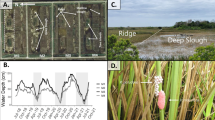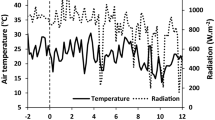Abstract
Nitrate pollution in springs in Florida has been suggested as a possible reason for declining populations of the Florida apple snail, Pomacea paludosa (Say). No correlation was found between snail density and nitrate concentration measured in six Florida springs. In laboratory studies examining short-term acute impacts of nitrate, adult and juvenile snail 96 h LC50 values could not be determined due to low mortality rates despite nitrate concentrations > 500 ppm. Juvenile snail growth was affected with EC50 values of 504 and 622 ppm nitrate, in two trials, respectively. Juvenile survival during the 14 d growth study fell below 50%, but again nitrate levels were very high (> 500 ppm). Given that snails exhibited little to no response to nitrate concentrations orders of magnitude greater than those found in Florida springs, we suggest that other factors, possibly including natural differences in habitat structure or changes in structure related to exotic plant invasions, may help explain the observed declines in apple snail abundance.
Similar content being viewed by others
References
Andrews W. J. (1994). Nitrate in ground water and spring water near four dairy farms in north Florida, 1990–93. Water-Resources Investigations Report 94–4162, U.S. Geological Survey, Tallahassee, FL
Best G. A., Bogacka T. and Niemirycz E. (1997). International River Water Quality: Pollution and Restoration. E & FN Spon, London
Bryan D. (2002). Limpkin (Aramus guarauna). In: Poole, A. (eds) The Birds of North America, No. 627, pp. The Birds of North America Inc, Philadelphia
Camargo J. A. and Ward J. V. (1995). Nitrate (NO3-N) toxicity to aquatic life: a proposal of safe concentrations for two species of nearctic freshwater invertebrates. Chemosphere 31: 3211–3216
Conrad J. (1990). Nitrate Pollution and Politics: Great Britain, the Federal Republic of Germany and the Netherlands. Avebury, Aldershot, England
Darby P. C., P. L., Valentine-Darby, R. E., Bennetts, J. D., Croop, H. F., Percival & W. M. Kitchens (1997). Ecological studies of apple snails (Pomacea paludosa, Say). St. Johns River Water Management District Special Publication SJ98-SP6, South Florida Water Management District and St. Johns River Water Management District, Palatka, FL
Darby P. C., Bennetts R. E., Croop J. D., Valentine-Darby P. L. and Kitchens W. M. (1999). Comparison of sampling techniques for quantifying abundance of the Florida apple snail (Pomacea paludosa Say). Journal of Molluscan Studies 65: 195–208
Darby P. C., Valentine-Darby P. L. and Percival H. F. (2003). Dry season survival in a Florida apple snail (Pomacea paludosa Say) population. Malacologia 45: 179–184
Darby P. C., Valentine-Darby P. L., Percival H. F. and Kitchens W. M. (2004). Florida apple snail (Pomacea paludosa Say) responses to lake habitat restoration activity. Archiv für Hydrobiologie 161: 561–575
Fenn M. E., Baron J. S., Allen E. B., Rueth H. M., Nydick K. R., Geiser L., Bowman W. D., Sickmann J. O., Meixner T., Johnson D. W. and Neitlich P. (2003). Ecological effects of nitrogen deposition in the western United States. Bioscience 53: 404–420
Fennessey M. S. and Cronk J. K. (1997). The effectiveness and restoration potential of riparian ecotones for the managment of nonpoint source pollution, particularly nitrate. Critical Reviews in Environmental Science and Technology 27: 285–317
Frederiksen B. S. (1995). National responses to the EC nitrate policy. Journal of Environmental Planning and Management 38: 253–264
Gutierrez A., Perera G., Yong M. and Fernandez J. A. (1997). Relationships of the prosobranch snails Pomacea paludosa, Tarebia granifera and Melanoides tuberculata with the abiotic environment and freshwater snail diversity in the central region of Cuba. Malacological Review 30: 39–44
Hanning G. W. (1979). Aspects of Reproduction in Pomacea paludosa (Mesogastropoda: Pilidae), M.Sc. Thesis. Florida State University, Tallahassee, FL
Hotelling H. (1953). New light on the correlation coefficient and its transforms. Journal of the Royal Statistical Society, Series B 15: 193–232
Jensen F. B. (1996). Uptake, elimination and effects of nitrite and nitrate in freshwater crayfish (Astacus astacus). Aquatic Toxicology 34: 95–104
Joyce J. C., Langeland K. A., T. K. Van, V. V. Vandiver and Jr. (1992). Organic sedimentation associated with hydrilla management. Journal of Aquatic Plant Management 30: 20–23
Karunaratne L. B. (2004). Effects of Habitat Structure on Apple Snail (Pomacea paludosa Say) Densities in the Everglades, M.Sc. Thesis. University of West Florida, Pensacola, FL
Lewis P. A., Klenim D. J., Lazorchak J. M., Norberg-King T. J., Peltier W. H. and Heber M. A. (2002). Short-term methods for estimating the chronic toxicity of effluents and receiving waters to freshwater invertebrates. EPA-821-R-02-013. U.S. Environmental Protection Agency, Cincinatti, OH
Meade M. E. and Watts S. A. (1995). Toxicity of ammonia, nitrite and nitrate to juvenile Australian crayfish, Cherax quadricarinatus. Journal of Shellfish Research 14: 341–346
Nazaryuk V. M., Klenova M. I. and Kalimullina F. R. (2002). Ecoagrochemical approaches to the problem of nitrate pollution in acroecosystems. Russian Journal of Ecology 33: 392–397
Pfaff J. D. (1993). Determination of inorganic anions by ion chromatography, method 300.0. U.S. Environmental Protection Agency, Cincinnati, OH
Reider, D., (1985). Standard evaluation procedure. Acute toxicity test for estuarine and marine organisms (mollusk 96-hour flow-through shell deposition study). Technical Document EPA 540/9-85-011, U.S. Environmental Protection Agency, Office of Pesticides Programs, Hazard Evaluation Division, Washington, DC
Rodgers J. A., Smith H. T. and Thayer D. D. (2001). Integrating nonindigenous aquatic plant control with protection of snail kite nests in Florida. Environmental Management 28: 31–37
Ronen D., Kanfi Y. and Magaritz M. (1983). Sources of nitrates in groundwater of the coastal plain of Israel. Evolution of ideas. Water Research 17: 1499–1503
Rouse J. D., Bishop C. A. and Struger J. (1999). Nitrogen pollution: an assessment of its threat to amphibian survival. Environmental Health Perspectives 107: 799–803
Schuytema G. S. and Nebeker A. V. (1999). Comparative effects of ammonium and nitrate compounds on Pacific treefrog and African clawed frog embryos. Environmental Contamination and Toxicology 36: 200–206
Scott G. and Crunkilton R. L. (2000). Acute and chronic toxicity of nitrate to fathead minnows (Pimephales promelas), Ceriodaphnia dubia and Daphnia magna. Environmental Toxicology and Chemistry 19: 2918–2922
Scott T. M., Means G. H., Means R. C. and Meegan R. P. (2002). First magnitude springs of Florida. Open File Report No. 85. Florida Department of Environmental Protection, Tallahassee, FL
Snyder N. F. and Snyder H. A. (1969). A comparative study of mollusk predation by limpkins, everglade kites and boat-tailed grackles. Living Bird 8: 177–223
Sokal R. R. and Rohlf F. J. (1995). Biometry. W.H. Freeman & Company, New York
Stevenson J. (2000). Florida’s springs strategies for protection and restoration. Florida Department of Environmental Protection, Tallahassee, FL
Stormer J., Jensen F. B. and Rankin J. C. (1996). Uptake of nitrite, nitrate and bromide in rainbow trout, Oncorhynchus mykiss: effects on ionic balance. Canadian Journal of Fisheries and Aquatic Sciences 53: 1943–1950
Tilak K. S., Lakshmi S. J. and Susan T. A. (2002). The toxicity of ammonia, nitrite, and nitrate to the fish, Catla catla (Hamilton). Journal of Environmental Biology 23: 147–149
Tsai S-J. and Chen J-C. (2002). Acute toxicity of nitrate on Penaeus monodon juveniles at different salinity levels. Aquaculture 213: 163–170
Turner R. L. (1998). Effects of submergence on embryonic survival and developmental rate of the Florida applesnail, Pomacea paludosa: implications for egg predation and marsh management. Florida Scientist 61: 118–129
Turner R. L. and Mikkelsen P. M. (2004). Annotated bibliography of the Florida applesnail, Pomacea paludosa (Say) (Gastropoda: Ampullariidae), from 1824–1999. Nemouria 48: 1–188
Watt P. J. and Oldham R. S. (1995). The effect of ammonium nitrate on the feeding and development of larvae of the smooth newt, Triturus vulgaris (L.) and on the behaviour of its food source, Daphnia. Freshwater Biology 33: 319–324
Xu Q. and Oldham R. S. (1997). Lethal and sublethal effects of nitrogen fertilizer ammonium nitrate on common toad (Bufo bufo) tabdpoles. Archives of Environmental Contamination and Toxicology 32: 298–303
Author information
Authors and Affiliations
Corresponding author
Rights and permissions
About this article
Cite this article
Corrao, N.M., Darby, P.C. & Pomory, C.M. Nitrate impacts on the Florida apple snail, Pomacea paludosa . Hydrobiologia 568, 135–143 (2006). https://doi.org/10.1007/s10750-006-0199-8
Received:
Revised:
Accepted:
Published:
Issue Date:
DOI: https://doi.org/10.1007/s10750-006-0199-8




